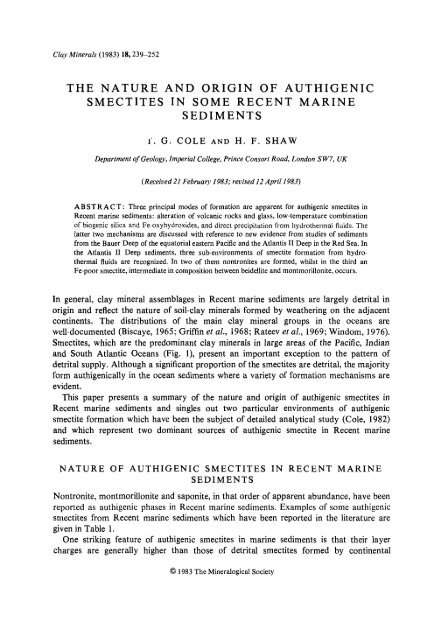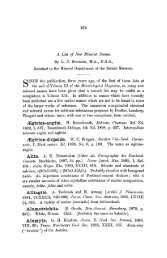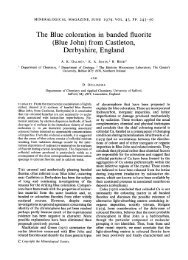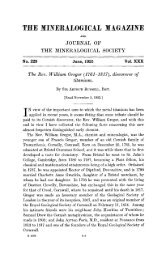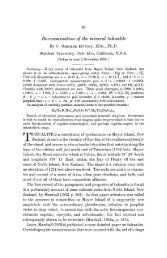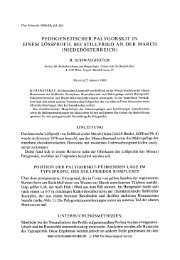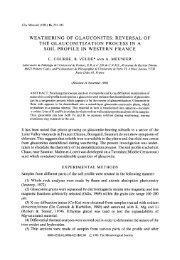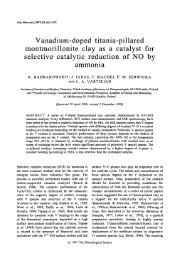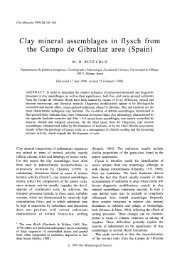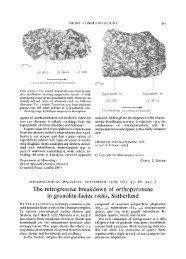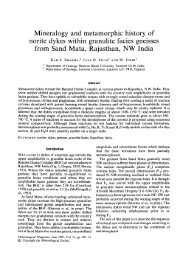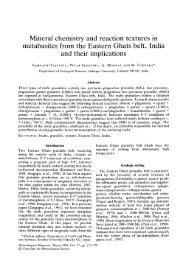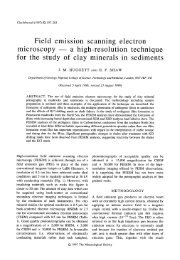the nature and origin of authigenic smectites in some recent marine ...
the nature and origin of authigenic smectites in some recent marine ...
the nature and origin of authigenic smectites in some recent marine ...
Create successful ePaper yourself
Turn your PDF publications into a flip-book with our unique Google optimized e-Paper software.
Clay M<strong>in</strong>erals (1983) 18, 239-252<br />
THE NATURE AND ORIGIN OF AUTHIGENIC<br />
SMECTITES IN SOME RECENT MARINE<br />
SEDIMENTS<br />
f. G. COLE AND H. F. SHAW<br />
Department <strong>of</strong> Geology, Imperial College, Pr<strong>in</strong>ce Consort Road, London SW7, UK<br />
(Received 21 February 1983; revised 12 April 1983)<br />
A B S T R A C T: Three pr<strong>in</strong>cipal modes <strong>of</strong> formation are apparent for <strong>authigenic</strong> <strong>smectites</strong> <strong>in</strong><br />
Recent mar<strong>in</strong>e sediments: alteration <strong>of</strong> volcanic rocks <strong>and</strong> glass, low-temperature comb<strong>in</strong>ation<br />
<strong>of</strong> biogenic silica <strong>and</strong> Fe oxyhydroxides, <strong>and</strong> direct precipitation from hydro<strong>the</strong>rmat fluids. The<br />
latter two mechanisms are discussed with reference to new evidence from studies <strong>of</strong> sediments<br />
from <strong>the</strong> Bauer Deep <strong>of</strong> <strong>the</strong> equatorial eastern Pacific <strong>and</strong> <strong>the</strong> Atlantis II Deep <strong>in</strong> <strong>the</strong> Red Sea. In<br />
<strong>the</strong> Atlantis II Deep sediments, three sub-environments <strong>of</strong> smectite formation from hydro-<br />
<strong>the</strong>rmal fluids are recognized. In two <strong>of</strong> <strong>the</strong>m nontronites are formed, whilst <strong>in</strong> <strong>the</strong> third an<br />
Fe-poor smectite, <strong>in</strong>termediate <strong>in</strong> composition between beidellite <strong>and</strong> montmorillonite, occurs.<br />
In general, clay m<strong>in</strong>eral assemblages <strong>in</strong> Recent mar<strong>in</strong>e sediments are largely detrital <strong>in</strong><br />
<strong>orig<strong>in</strong></strong> <strong>and</strong> reflect <strong>the</strong> <strong>nature</strong> <strong>of</strong> soil-clay m<strong>in</strong>erals formed by wea<strong>the</strong>r<strong>in</strong>g on <strong>the</strong> adjacent<br />
cont<strong>in</strong>ents. The distributions <strong>of</strong> <strong>the</strong> ma<strong>in</strong> clay m<strong>in</strong>eral groups <strong>in</strong> <strong>the</strong> oceans are<br />
well-documented (Biscaye, 1965; Griff<strong>in</strong> et al., 1968; Rateev et aL, 1969; W<strong>in</strong>dom, 1976).<br />
Smectites, which are <strong>the</strong> predom<strong>in</strong>ant clay m<strong>in</strong>erals <strong>in</strong> large areas <strong>of</strong> <strong>the</strong> Pacific, Indian<br />
<strong>and</strong> South Atlantic Oceans (Fig. 1), present an important exception to <strong>the</strong> pattern <strong>of</strong><br />
detrital supply. Although a significant proportion <strong>of</strong> <strong>the</strong> <strong>smectites</strong> are detrital, <strong>the</strong> majority<br />
form <strong>authigenic</strong>ally <strong>in</strong> <strong>the</strong> ocean sediments where a variety <strong>of</strong> formation mechanisms are<br />
evident.<br />
This paper presents a summary <strong>of</strong> <strong>the</strong> <strong>nature</strong> <strong>and</strong> <strong>orig<strong>in</strong></strong> <strong>of</strong> <strong>authigenic</strong> <strong>smectites</strong> <strong>in</strong><br />
Recent mar<strong>in</strong>e sediments <strong>and</strong> s<strong>in</strong>gles out two particular environments <strong>of</strong> <strong>authigenic</strong><br />
smectite formation which have been <strong>the</strong> subject <strong>of</strong> detailed analytical study (Cole, 1982)<br />
<strong>and</strong> which represent two dom<strong>in</strong>ant sources <strong>of</strong> <strong>authigenic</strong> smectite <strong>in</strong> Recent mar<strong>in</strong>e<br />
sediments.<br />
NATURE OF AUTHIGENIC SMECTITES IN RECENT MARINE<br />
SEDIMENTS<br />
Nontronite, montmorillonite <strong>and</strong> saponite, <strong>in</strong> that order <strong>of</strong> apparent abundance, have been<br />
reported as <strong>authigenic</strong> phases <strong>in</strong> Recent mar<strong>in</strong>e sediments. Examples <strong>of</strong> <strong>some</strong> <strong>authigenic</strong><br />
<strong>smectites</strong> from Recent mar<strong>in</strong>e sediments which have been reported <strong>in</strong> <strong>the</strong> literature are<br />
given <strong>in</strong> Table 1.<br />
One strik<strong>in</strong>g feature <strong>of</strong> <strong>authigenic</strong> <strong>smectites</strong> <strong>in</strong> mar<strong>in</strong>e sediments is that <strong>the</strong>ir layer<br />
charges are generally higher than those <strong>of</strong> detrital <strong>smectites</strong> formed by cont<strong>in</strong>ental<br />
(~) 1983 The M<strong>in</strong>eralogical Society
240 T. G. Cole <strong>and</strong> H. F. Shaw<br />
c..t\~,~,
Smectites <strong>in</strong> Recent sediments<br />
TABLE l, Nature <strong>of</strong> <strong>smectites</strong> <strong>in</strong> modern mar<strong>in</strong>e sediments.<br />
Clay m<strong>in</strong>eral Location Interlayer cations Reference<br />
Nontronite Bauer Deep C ao.oTNa o. 16Ko . 37 Dymond &<br />
Eklund (1978)<br />
Cao.23Nao.v2Ko.22 McMurtry & Yeh<br />
(1981)<br />
Cao.loNao.4oKo.lz Cole (1982)<br />
Galapagos C a o. uNao.47Ko.41 Corliss et al. (1978)<br />
C ao.ozNao.39Ko.42 Corliss et al. (1978)<br />
Fe-rich montmorillonite<br />
Saponite-Nontronite<br />
Saponite<br />
Red Sea Cao.ogNavooKo.o7 Bisch<strong>of</strong>f (1972)<br />
C ao.o3Nao.8oK o. 14 Bisch<strong>of</strong>f (1972)<br />
C ao.o9Na o. 94K0 . 32 Bisch<strong>of</strong>f ( 1972)<br />
241<br />
C a o. loNav loKo . 18 Bisch<strong>of</strong>f (1972)<br />
Gulf&Aden Not known Cann et al. (1977)<br />
Mid-Atlantic<br />
(FAMOUS)<br />
Not known Rona et al. (1976)<br />
NE Pacific Cao.o2Nao.36Ko.14 Aoki et al. (1974)<br />
Cao.o6Nao.38Koq2 Aoki et al. (1974)<br />
Cao.osNao.a6Ko.14 Aoki et al. 0974)<br />
Caoq4Nao.42Ko.12 Aoki et al. (1974)<br />
SE Pacific Cao.oTNao.86Koq 1 Aoki et al. (1979)<br />
Pacific (DOMES) Cao.28Nao.azKo.44 He<strong>in</strong> et al. (1979)<br />
St. Pauls Rocks Cao.osNao.21Ko.4z Melson & Thompson<br />
(Atlantic)<br />
(1973)<br />
St. Pauls Rocks<br />
(Atlantic)<br />
Cao.t0Nao.29Ko.42 Melson & Thompson<br />
(1973)<br />
Peru Trench Cao.34Nao.6oKo,24 Scheidegger & Stakes<br />
(1977)<br />
wea<strong>the</strong>r<strong>in</strong>g. In <strong>some</strong> cases <strong>the</strong> reported layer charges exceed <strong>the</strong> def<strong>in</strong>ed limit for <strong>smectites</strong><br />
(1.2 equivalents <strong>of</strong> charge per 020(OH)4 formula unit).<br />
These apparently excessive layer charges could simply arise because no account was<br />
taken <strong>of</strong> <strong>the</strong> presence <strong>of</strong> amorphous iron <strong>and</strong> o<strong>the</strong>r oxides <strong>and</strong> f<strong>in</strong>e-gra<strong>in</strong>ed m<strong>in</strong>eral<br />
impurities <strong>in</strong> <strong>the</strong> analysis sample when <strong>the</strong> structural formula was calculated. Also,<br />
<strong>authigenic</strong> <strong>smectites</strong> <strong>in</strong> Recent mar<strong>in</strong>e sediments, particularly <strong>the</strong> nontronites, <strong>of</strong>ten occur<br />
<strong>in</strong> environments conta<strong>in</strong><strong>in</strong>g higher than average concentrations <strong>of</strong> trace elements for<br />
pelagic clays. The trace elements may become <strong>in</strong>corporated <strong>in</strong> <strong>the</strong> smectite structure<br />
dur<strong>in</strong>g formation but <strong>the</strong>y are not always accounted for <strong>in</strong> calculations <strong>of</strong> layer charge.<br />
ORIGIN OF AUTHIGENIC SMECTITES IN RECENT MARINE<br />
SEDIMENTS<br />
The <strong>orig<strong>in</strong></strong> <strong>of</strong> <strong>authigenic</strong> <strong>smectites</strong> <strong>in</strong> Recent mar<strong>in</strong>e sediments may be summarized <strong>in</strong><br />
terms <strong>of</strong> three separate mechanisms.<br />
Alteration <strong>of</strong> volcanic rock fragments <strong>and</strong> glass<br />
Significant proportions <strong>of</strong> basalts recovered dur<strong>in</strong>g <strong>the</strong> DSDP <strong>and</strong> IPOD drill<strong>in</strong>g<br />
programmes have been found to be altered to various clay m<strong>in</strong>erals. Iron-bear<strong>in</strong>g saponites<br />
are <strong>the</strong> most widespread, occurr<strong>in</strong>g as ve<strong>in</strong>s <strong>in</strong> <strong>the</strong> groundmass, <strong>in</strong>fill<strong>in</strong>g vesicles, <strong>and</strong>
242 T. G. Cole <strong>and</strong> H. F. Shaw<br />
replac<strong>in</strong>g phenocrysts <strong>and</strong> glass <strong>of</strong> <strong>the</strong> altered basalts (Banks, 1972; Melson &<br />
Thompson, 1973; Scheidegger & Stakes, 1977; Vallier & Kidd, 1977; Seyfried et'al.,<br />
1978; Kurnosov et al., 1982). The saponites form by <strong>the</strong> reaction <strong>of</strong> basalts with juvenile<br />
water or seawater under reduc<strong>in</strong>g alkal<strong>in</strong>e conditions at temperatures rang<strong>in</strong>g from 400~<br />
to normal ocean-bottom temperatures (Kurnosov et al., 1982).<br />
Kurnosov et al. (1982) also concluded that under oxidiz<strong>in</strong>g conditions at relatively low<br />
temperatures (
o<br />
o<br />
eo<br />
Smeetites <strong>in</strong> Recent sediments 243<br />
- -_ 9 ee<br />
O.<br />
t~<br />
; o7oo %<br />
110 ~ 100 ~ 90 ~ 80 ~<br />
FIG. 2. Location <strong>of</strong> <strong>the</strong> Bauer Deep, sou<strong>the</strong>ast Pacific.<br />
..<br />
2.., 9 -<br />
;;...<br />
I',~:, 2o:<br />
!l .....<br />
P IL? , "<br />
i . . . . . 9<br />
3. ' 9<br />
2::'.- .'<br />
',.' 9 ,<br />
i:"... *o~<br />
,..... . . .<br />
The Bauer Deep sediments represent an <strong>of</strong>f-ocean ridge metalliferous deposit hav<strong>in</strong>g a<br />
trace element content similar to <strong>the</strong> metalliferous sediments <strong>of</strong> <strong>the</strong> adjacent East Pacific<br />
Rise when <strong>the</strong> latter are expressed on a carbonate-free basis. The Bauer Deep nontronite is<br />
<strong>the</strong>refore an example <strong>of</strong> an <strong>authigenic</strong> smectite associated with higher than average pelagic<br />
clay concentrations <strong>of</strong> trace elements.<br />
Scann<strong>in</strong>g electron microscopy (SEM) <strong>of</strong> sediment specimens from <strong>the</strong> Bauer Deep<br />
shows that <strong>the</strong> siliceous micr<strong>of</strong>ossils are well-preserved <strong>in</strong> <strong>the</strong> surface horizons <strong>of</strong> <strong>the</strong><br />
sediment (Fig. 3a). However, <strong>the</strong> micr<strong>of</strong>ossils undergo corrosion dur<strong>in</strong>g burial, with<br />
<strong>in</strong>fill<strong>in</strong>g <strong>and</strong> replacement <strong>of</strong> <strong>the</strong> skeletal structures by nontronite (Fig 3b). The micr<strong>of</strong>ossils<br />
appear to provide a substrate for <strong>the</strong> <strong>authigenic</strong> growth <strong>of</strong> nontronite (Fig. 3c), suggest<strong>in</strong>g<br />
1.5:" "
244 T. G. Cole <strong>and</strong> H. F. Shaw<br />
FIG 3. Scann<strong>in</strong>g electron micrographs <strong>of</strong> sediments from <strong>the</strong> Bauer Deep. (a) Well-preserved<br />
siliceous micr<strong>of</strong>ossils <strong>in</strong> surface sediments (x 1200); (b) Corrosion <strong>and</strong> nontronite <strong>in</strong>fiIl<strong>in</strong>g <strong>of</strong><br />
siliceous micr<strong>of</strong>ossils <strong>in</strong> buried sediments (x 1200); (c) Nontronite <strong>in</strong>fill<strong>in</strong>g <strong>of</strong> siliceous<br />
micr<strong>of</strong>ossils (x 3200).<br />
that <strong>the</strong> silica source for <strong>the</strong> clay m<strong>in</strong>eral is biogenic <strong>in</strong> <strong>orig<strong>in</strong></strong>. Qualitative elemental<br />
analysis <strong>of</strong> <strong>the</strong> <strong>in</strong>fill<strong>in</strong>g clay material <strong>in</strong>dicated that it was composed predom<strong>in</strong>antly <strong>of</strong> Si<br />
<strong>and</strong> Fe.<br />
The iron necessary for <strong>the</strong> formation <strong>of</strong> <strong>the</strong> nontronite <strong>orig<strong>in</strong></strong>ates from <strong>the</strong> East Pacific<br />
Rise as a hydro<strong>the</strong>rmal precipitate. This is transported, along with o<strong>the</strong>r trace elements, as<br />
X-ray amorphous Fe- (<strong>and</strong> Mn-)oxyhydroxide flocs which are ponded <strong>in</strong> <strong>the</strong> Bauer Deep<br />
(Dymond & Veeh, 1975; Lonsdale, 1976; Heath & Dymond, 1977; 1981; Edmond et al.,<br />
1982; Cole, 1982). The Fe-oxyhydroxide probably becomes associated with <strong>the</strong> biogenic<br />
opal <strong>in</strong> <strong>the</strong> Bauer Deep sediments by coord<strong>in</strong>ation <strong>of</strong> Fe(III) to silanol groups (SiO-) at<br />
<strong>the</strong> surfaces <strong>of</strong> <strong>the</strong> dissolv<strong>in</strong>g micr<strong>of</strong>auna to form an Fe(III)-Si complex which is <strong>the</strong><br />
precursor <strong>of</strong> <strong>the</strong> nontronite. Harder (1976; 1978) has syn<strong>the</strong>sized Fe-rich layer-silicates,
Smeetites <strong>in</strong> Recent sediments 245<br />
<strong>in</strong>clud<strong>in</strong>g nontronite, at low temperatures (
246 T. G. Cole <strong>and</strong> H. F. Shaw<br />
35 ~ 36 ~ 37 ~ 38 ~ 319~ 40 ~<br />
I I I I I<br />
Oceanographer Deep<br />
Kebrit Deep<br />
f<br />
.Gypsum Deep<br />
=ma Deep<br />
Nereus Deep<br />
41 ~ 42 o<br />
I I<br />
Thetis Deep ~ o //~Atlantis II Deep<br />
W<strong>and</strong>o Bas<strong>in</strong> ~ ,Cha<strong>in</strong> Deeps<br />
Valdivia Dee<br />
P~<br />
--ll~e/ )~Djidda<br />
I i- ee_____~Albatross Deep<br />
DeepJ e ~ a<br />
Discovery j Deep<br />
Erba Deep I |<br />
Port Sudan ~////)<br />
Port Sudan DeeD<br />
Suak<strong>in</strong> Dee<br />
9 Deeps with br<strong>in</strong>e & metalliferous sediment.<br />
9 Deeps with metalliferous sediment only.<br />
| Deeps with br<strong>in</strong>e only.<br />
FIG. 4. Location <strong>of</strong> <strong>the</strong> Atlantis II Deep, Red Sea.<br />
work by Bisch<strong>of</strong>f (1972) showed that <strong>the</strong> nontronites from <strong>the</strong>se sediments had a typical<br />
composition <strong>of</strong><br />
9 . 3+ OH nH O<br />
Cao.09Nal.ooKo.07(Fe~+aFe~+3Mno.18Zno.41Cuo llMgo.41) (S16.74Alo.48Feo.80)O20( )4. 2 ~<br />
From <strong>the</strong> previous work <strong>of</strong> Bisch<strong>of</strong>f (1972) <strong>the</strong> nontronites appeared to be poorly<br />
crystall<strong>in</strong>e. However, <strong>recent</strong> XRD analyses carried out by Cole (1982) <strong>in</strong>dicate that <strong>the</strong><br />
nontronites are 'well crystallized' (v/p ratio 0.80-0.85).<br />
Scann<strong>in</strong>g electron microscope exam<strong>in</strong>ation <strong>of</strong> <strong>the</strong> nontronites showed that <strong>the</strong>y had a<br />
flaky, <strong>of</strong>ten 'honeycombed', texture (Fig. 5a) typical <strong>of</strong> <strong>smectites</strong> (Bohor & Hughes,<br />
1971). However, <strong>the</strong> nontronite <strong>in</strong> <strong>the</strong> sulphide/silicate/amorphous facies may also occur<br />
with a fibrous texture (Fig. 5b). This is a relatively unusual morphology for <strong>smectites</strong><br />
(Kurnosov et al., 1982).<br />
E<br />
--26"<br />
29 ~<br />
28 ~<br />
27 ~<br />
--25 ~<br />
--24 ~<br />
22 ~<br />
21 ~<br />
20 ~<br />
19 ~<br />
118 ~<br />
I17 ~<br />
16 ~<br />
15 ~
Smectites <strong>in</strong> Recent sediments 247<br />
FIG. 5. Scann<strong>in</strong>g electron micrographs <strong>of</strong> sediments from <strong>the</strong> Atlantis II Deep. (a) Flaky texture<br />
<strong>of</strong> nontronite <strong>in</strong> sulphide/silicate/amorphous facies ( 570); (b) Fibrous texture <strong>of</strong> nontronite <strong>in</strong><br />
sulphide/silicate/amorphous facies (x2400); (c) Flaky/fibrous texture <strong>of</strong> nontronite <strong>in</strong><br />
silicate/carbonate/oxide facies (x4000); (d) Flaky texture <strong>of</strong> montmorillonite-beidellite <strong>in</strong><br />
sulphate/sulphide/silicate/oxide facies (x 1330).<br />
The formation <strong>of</strong> <strong>the</strong> nontronite <strong>in</strong> <strong>the</strong> sulphide/silicate/amorphous facies is thought to<br />
occur by sorption <strong>of</strong> silica supplied by <strong>the</strong> <strong>in</strong>com<strong>in</strong>g hydro<strong>the</strong>rmal br<strong>in</strong>es onto<br />
Fe-oxyhydroxide which settled from <strong>the</strong> upper br<strong>in</strong>e pool layers; an Fe(III)-Si complex<br />
analogous to <strong>the</strong> precursor <strong>of</strong> <strong>the</strong> Bauer Deep nontronite results. This mechanism is<br />
supported by oxygen isotope data which <strong>in</strong>dicate that <strong>the</strong> nontronite has a formation<br />
temperature <strong>in</strong> <strong>the</strong> range 90-140~ (Cole, 1982). This ra<strong>the</strong>r wide temperature range may<br />
be accounted for <strong>in</strong> terms <strong>of</strong> precise sample location <strong>in</strong> <strong>the</strong> facies but, overall, it is<br />
<strong>in</strong>termediate between <strong>the</strong> temperature <strong>of</strong> <strong>the</strong> <strong>in</strong>com<strong>in</strong>g br<strong>in</strong>e, which may be as high as<br />
250~ (Shanks & Bisch<strong>of</strong>f, 1977), <strong>and</strong> <strong>the</strong> temperature <strong>of</strong> <strong>the</strong> deep br<strong>in</strong>e pool which is<br />
about 60~ (Hartmann, 1980). The temperature range reflects mix<strong>in</strong>g <strong>of</strong> isotopically light<br />
SIO2, which equilibrated at high temperatures with sub-surface br<strong>in</strong>es, <strong>and</strong> isotopically
248 T. G. Cole <strong>and</strong> H. F. Shaw<br />
heavier Fe-oxyhydroxide, which equilibrated at lower temperatures <strong>in</strong> <strong>the</strong> upper br<strong>in</strong>e pool<br />
layers.<br />
This nontronite is <strong>the</strong> dom<strong>in</strong>ant constituent <strong>of</strong> <strong>the</strong> sulphide/silicate/amorphous facies<br />
which is form<strong>in</strong>g at <strong>the</strong> present day over most <strong>of</strong> <strong>the</strong> Atlantis II Deep <strong>in</strong> <strong>the</strong> anoxic layers<br />
<strong>of</strong> <strong>the</strong> br<strong>in</strong>e pool, <strong>and</strong> represents <strong>the</strong> thickest <strong>and</strong> most cont<strong>in</strong>uous facies <strong>in</strong> <strong>the</strong> Deep<br />
overall (Backer & Richter, 1973; Hackett & Bisch<strong>of</strong>f, 1973). Consequently, <strong>the</strong> nontronite<br />
<strong>in</strong> this facies is quantitatively one <strong>of</strong> <strong>the</strong> most important phases <strong>in</strong> <strong>the</strong> metalliferous<br />
sediments as a whole.<br />
The second environment <strong>of</strong> smectite formation <strong>in</strong> <strong>the</strong> Atlantis II Deep is also<br />
characterized by nontronite formation but <strong>in</strong> association with poorly crystallized<br />
Fe(III)-oxide <strong>and</strong> manganosiderite; this association was def<strong>in</strong>ed as <strong>the</strong> silicate/carbonate/<br />
oxide facies by Cole (1982). X-ray diffraction analysis <strong>of</strong> bulk samples <strong>and</strong> clay fractions<br />
<strong>of</strong> <strong>the</strong> sediments from this facies showed <strong>the</strong> nontronite to have similar characteristics to<br />
<strong>the</strong> nontronite from <strong>the</strong> anoxic facies described above. The nontronite was also well<br />
crystallized with a v/p ratio <strong>of</strong> 0.85-0.90.<br />
The Fe-rich <strong>nature</strong> <strong>of</strong> <strong>the</strong> nontronite was confirmed by chemical analysis dur<strong>in</strong>g SEM<br />
exam<strong>in</strong>ation <strong>of</strong> <strong>the</strong> sediments. The SEM analysis also showed that <strong>the</strong> nontronite aga<strong>in</strong><br />
exhibited both flaky <strong>and</strong> fibrous morphologies similar to <strong>the</strong> nontronites from <strong>the</strong> anoxic<br />
facies (Fig. 5c).<br />
The occurrence <strong>of</strong> a nontronite <strong>in</strong> oxic sediments hav<strong>in</strong>g this m<strong>in</strong>eral association has<br />
been reported from <strong>the</strong> Atlantis II Deep (Goulart, 1976) but it has not previously been<br />
dist<strong>in</strong>guished from <strong>the</strong> nontronite <strong>of</strong> <strong>the</strong> anoxic sulphide/silicate/amorphous facies.<br />
The <strong>orig<strong>in</strong></strong> <strong>of</strong> <strong>the</strong> nontronite <strong>in</strong> this facies is probably similar to that <strong>of</strong> <strong>the</strong> nontronite<br />
from <strong>the</strong> anoxic material but, ow<strong>in</strong>g to its occurrence <strong>in</strong> oxic sediments, its formation<br />
mechanism may differ <strong>in</strong> detail. For example, <strong>the</strong> nontronite <strong>in</strong> <strong>the</strong> oxic sediments may<br />
<strong>in</strong>corporate a higher Fe: Si ratio than <strong>the</strong> nontronite occurr<strong>in</strong>g <strong>in</strong> <strong>the</strong> anoxic sediments.<br />
This would reflect its association with sediments which characterize <strong>the</strong> lower-temperature<br />
oxic end <strong>of</strong> <strong>the</strong> m<strong>in</strong>eral fractionation sequence <strong>of</strong> <strong>the</strong> geo<strong>the</strong>rmal system, at <strong>the</strong> periphery<br />
<strong>of</strong> <strong>the</strong> Atlantis II Deep. This hypo<strong>the</strong>sis is aga<strong>in</strong> supported by oxygen isotope data which<br />
<strong>in</strong>dicate a formation temperature for <strong>the</strong> nontronite <strong>of</strong> <strong>the</strong> silicate/carbonate/oxide facies<br />
<strong>of</strong> ~ 80 ~ C (Cole, 1982). This temperature is below <strong>the</strong> formation temperature range <strong>of</strong> <strong>the</strong><br />
nontronite <strong>in</strong> <strong>the</strong> anoxic sediments but it is sufficiently high for a similar formation<br />
mechanism to be applicable.<br />
The third environment <strong>of</strong> smectite formation is characterized by an Fe-poor smectite.<br />
Detailed X-ray diffraction analyses, <strong>in</strong>clud<strong>in</strong>g <strong>the</strong> application <strong>of</strong> <strong>the</strong> Greene-Kelly test<br />
(MacEwan & Wilson, 1980), <strong>in</strong>dicated that this smectite had a composition <strong>in</strong>termediate<br />
between that <strong>of</strong> montmorillonite <strong>and</strong> beidellite. The montmorillonite-beidellite showed<br />
unusual behaviour on heat<strong>in</strong>g. Complete collapse did not occur at 400~ <strong>and</strong> heat<strong>in</strong>g to<br />
>500~ was necessary for this. The Fe-poor <strong>nature</strong> <strong>of</strong> <strong>the</strong> smectite was also confirmed<br />
from chemical analysis <strong>of</strong> <strong>the</strong> clay dur<strong>in</strong>g scann<strong>in</strong>g electron microscopy. Fe-poor varieties<br />
<strong>of</strong> smectite <strong>in</strong> <strong>the</strong> Atlantis II Deep have not previously been reported.<br />
This variety <strong>of</strong> smectite is well crystallized with a v/p ratio <strong>of</strong> 0.85-0.90. However,<br />
unlike <strong>the</strong> <strong>authigenic</strong> nontronites from <strong>the</strong> Atlantis II Deep described above, <strong>the</strong><br />
montmorillonite-beidellite only shows a flaky morphology with no evidence <strong>of</strong> fibrous<br />
texture (Fig. 5d). The montmorillonite-beidellite occurs associated with anhydrite <strong>and</strong><br />
sulphides <strong>and</strong> localized occurrences <strong>of</strong> hematite; this was def<strong>in</strong>ed as <strong>the</strong> sulphate/<br />
sulphide/silicate/oxide facies by Cole (1982). This facies represented <strong>the</strong> lowermost 2 m<br />
section underly<strong>in</strong>g 70 cm <strong>of</strong> sulphide/silicate/amorphous facies (uppermost unit) <strong>in</strong> a
Smectites <strong>in</strong> Recent sediments 249<br />
s<strong>in</strong>gle 2.7 m gravity core. The detailed m<strong>in</strong>eralogy <strong>of</strong> this facies reflects a ra<strong>the</strong>r complex<br />
depositional history where <strong>the</strong> m<strong>in</strong>erals did not all form contemporaneously. However, <strong>the</strong><br />
m<strong>in</strong>eralogical data <strong>in</strong>dicate that formation <strong>of</strong> this facies was associated with active br<strong>in</strong>e<br />
discharge <strong>and</strong> that <strong>the</strong> core was probably recovered at <strong>the</strong> site <strong>of</strong> an ext<strong>in</strong>ct vent. This is<br />
supported by oxygen isotope data for <strong>the</strong> smectite <strong>of</strong> this facies which <strong>in</strong>dicate a formation<br />
temperature <strong>in</strong> <strong>the</strong> range 160-200~ (Cole, 1982). This is approach<strong>in</strong>g <strong>the</strong> estimated<br />
temperature <strong>of</strong> <strong>the</strong> subsurface br<strong>in</strong>e just prior to discharge (Shanks & Bisch<strong>of</strong>f, 1977).<br />
The m<strong>in</strong>eralogical <strong>and</strong> isotopic evidence available suggest that this variety <strong>of</strong> smectite<br />
formed by direct precipitation <strong>of</strong> Si <strong>and</strong> A1, both supplied from a discharg<strong>in</strong>g hydro<strong>the</strong>rmal<br />
br<strong>in</strong>e, at <strong>the</strong> site <strong>of</strong> a once-active vent. The very high formation temperature range <strong>of</strong> <strong>the</strong><br />
montmorillonite-beidellite would appear to exclude any significant <strong>in</strong>volvement <strong>of</strong>, or<br />
exchange with, o<strong>the</strong>r possible sources <strong>of</strong> oxygen besides that associated with <strong>the</strong><br />
br<strong>in</strong>e-derived Si <strong>and</strong> A1, such as dissolved 02 or H20-oxygen derived from elsewhere <strong>in</strong> <strong>the</strong><br />
br<strong>in</strong>e pool--unless <strong>the</strong>y became <strong>in</strong>corporated <strong>in</strong>to <strong>the</strong> montmorillonite-beidellite <strong>in</strong> <strong>the</strong><br />
vic<strong>in</strong>ity <strong>of</strong> <strong>the</strong> br<strong>in</strong>e discharge. Therefore <strong>the</strong> formation-temperature range <strong>of</strong> this smectite<br />
probably reflects <strong>the</strong> temperature range <strong>in</strong> which dissolved SiO2 <strong>in</strong> <strong>the</strong> <strong>in</strong>com<strong>in</strong>g br<strong>in</strong>e<br />
becomes supersaturated <strong>and</strong> fixes its isotopic composition by precipitation from solution.<br />
Incorporation <strong>of</strong> <strong>the</strong> SiO 2 <strong>in</strong>to <strong>the</strong> montmorillonite-beidellite <strong>in</strong> <strong>the</strong> vic<strong>in</strong>ity <strong>of</strong> <strong>the</strong> br<strong>in</strong>e<br />
discharge vent would <strong>the</strong>n enable this clay m<strong>in</strong>eral to reta<strong>in</strong> <strong>the</strong> high-temperature impr<strong>in</strong>t<br />
<strong>of</strong> <strong>the</strong> SiO 2.<br />
The montmorillonite-beidellite represents a quantitatively important phase <strong>in</strong> <strong>the</strong><br />
sulphate/sulphide/silicate/oxide facies, but ow<strong>in</strong>g to its unique association with active<br />
br<strong>in</strong>e discharge it is probable that nei<strong>the</strong>r this smectite species nor <strong>the</strong> facies itself are <strong>of</strong><br />
quantitative importance <strong>in</strong> <strong>the</strong> Atlantis II Deep as a whole; <strong>the</strong> anoxic nontronite <strong>and</strong> <strong>the</strong><br />
sulphide/silicate/amorphous facies are, respectively, <strong>the</strong> more commonly occurr<strong>in</strong>g<br />
smectite variety <strong>and</strong> silicate-conta<strong>in</strong><strong>in</strong>g facies.<br />
CONCLUSIONS<br />
From <strong>the</strong> above discussion it is evident that a variety <strong>of</strong> di- <strong>and</strong> tri-octahedral <strong>smectites</strong><br />
can form <strong>authigenic</strong>ally. Three pr<strong>in</strong>cipal mechanisms account for <strong>the</strong>ir formation:<br />
alteration <strong>of</strong> volcanic rock fragments <strong>and</strong> glasses, low-temperature comb<strong>in</strong>ation <strong>of</strong><br />
Fe-oxyhydroxides <strong>and</strong> biogenic silica, <strong>and</strong> direct precipitation from hydro<strong>the</strong>rmal fluids.<br />
The nontronites are <strong>the</strong> most widespread <strong>of</strong> <strong>the</strong> <strong>authigenic</strong> <strong>smectites</strong>. They form by all<br />
three mechanisms outl<strong>in</strong>ed above over a wide range <strong>of</strong> temperatures <strong>and</strong> physico-chemical<br />
conditions. In particular, isotopic, chemical, <strong>and</strong> m<strong>in</strong>eralogical data have shown that <strong>in</strong> <strong>the</strong><br />
Bauer Deep <strong>of</strong> <strong>the</strong> sou<strong>the</strong>ast Pacific, well-crystallized nontronites are generated at normal<br />
ocean-bottom water temperatures <strong>of</strong> 2-3~ under generally oxic conditions by <strong>the</strong><br />
comb<strong>in</strong>ation <strong>of</strong> Fe-oxyhydroxides <strong>and</strong> biogenic silica. In <strong>the</strong> Atlantis II Deep <strong>of</strong> <strong>the</strong> Red<br />
Sea, formation <strong>of</strong> well-crystallized nontronite also occurs but by direct precipitation from<br />
hydro<strong>the</strong>rmal fluids (br<strong>in</strong>es) over a wide range <strong>of</strong> temperatures, <strong>and</strong> <strong>in</strong> both oxic <strong>and</strong><br />
anoxic environments. In <strong>the</strong> oxic environment <strong>the</strong> formation temperature is 80~ while <strong>in</strong><br />
<strong>the</strong> anoxic environment formation temperatures <strong>in</strong> <strong>the</strong> range 90-140~ have been<br />
measured. Although not a subject <strong>of</strong> analytical attention <strong>in</strong> <strong>the</strong> present work, nontronite<br />
formation by low-temperature (
250 T. G. Cole <strong>and</strong> H. F. Shaw<br />
The necessity <strong>of</strong> an Fe-oxyhydroxide precursor for nontronite formation is obvious<br />
with regard to <strong>the</strong> mechanism <strong>in</strong>volv<strong>in</strong>g low-temperature comb<strong>in</strong>ation <strong>of</strong> Fe-oxyhydroxide<br />
<strong>and</strong> biogenic silica, but it is apparent that a similar precursor is also required <strong>in</strong> <strong>the</strong><br />
mechanism <strong>in</strong>volv<strong>in</strong>g precipitation <strong>of</strong> nontronite from hydro<strong>the</strong>rmal fluids, <strong>in</strong> particular <strong>the</strong><br />
hydro<strong>the</strong>rmal br<strong>in</strong>es <strong>of</strong> <strong>the</strong> Atlantis II Deep. Indirect support for this requirement <strong>in</strong> <strong>the</strong><br />
case <strong>of</strong> nontronite precipitation from <strong>the</strong> Atlantis II Deep br<strong>in</strong>es is apparent from <strong>the</strong><br />
exceptional occurrence <strong>of</strong> <strong>the</strong> Fe-poor montmorillonite-beidellite <strong>in</strong> <strong>the</strong> Atlantis II Deep<br />
associated with active br<strong>in</strong>e discharge. In <strong>the</strong> vic<strong>in</strong>ity <strong>of</strong> <strong>the</strong> hydro<strong>the</strong>rmal vents, <strong>the</strong><br />
conditions would be too anoxic to host an Fe-oxyhydroxide precursor for possible<br />
nontronite formation <strong>and</strong>, as observed, under <strong>the</strong>se circumstances precipitation <strong>of</strong> an<br />
Fe-poor smectite occurs. Conversely, formation <strong>of</strong> <strong>the</strong> Fe-poor smectite <strong>in</strong> <strong>the</strong> Atlantis II<br />
Deep does not appear to compete with <strong>the</strong> nontronite formation as it is not found<br />
<strong>in</strong>termixed with <strong>the</strong> nontronites. This is probably due to <strong>the</strong> predom<strong>in</strong>ance <strong>of</strong> <strong>the</strong><br />
nontronite formation mechanism <strong>and</strong> because <strong>the</strong> ALsupply <strong>of</strong> <strong>the</strong> discharg<strong>in</strong>g br<strong>in</strong>es is<br />
only limited. The extent <strong>of</strong> Fe-poor smectite formation is <strong>the</strong>refore restricted to localized<br />
occurrences only, associated with active br<strong>in</strong>e discharge, <strong>and</strong>, except at br<strong>in</strong>e discharge<br />
sites, nontronite precipitation <strong>in</strong>volv<strong>in</strong>g an Fe-oxyhydroxide precursor appears to be <strong>the</strong><br />
dom<strong>in</strong>ant mode <strong>of</strong> smectite formation <strong>in</strong> <strong>the</strong> Atlantis II Deep.<br />
Clearly, where nontronite formation <strong>in</strong> <strong>the</strong> Recent mar<strong>in</strong>e environment does <strong>in</strong>volve an<br />
Fe-oxyhydroxide precursor, this sets an important constra<strong>in</strong>t on <strong>the</strong> range <strong>of</strong> redox<br />
conditions under which <strong>the</strong> formation reaction can take place, at least <strong>in</strong> its early stages.<br />
Later stages appear to be less constra<strong>in</strong>ed by redox conditions, although Harder (1976;<br />
1978) concluded from laboratory syn<strong>the</strong>sis experiments that nontronite precipitation is<br />
achieved at surface temperatures by nucleation under oxidiz<strong>in</strong>g conditions followed by<br />
age<strong>in</strong>g under reduc<strong>in</strong>g conditions. The dom<strong>in</strong>ant smectite formation environment <strong>in</strong> <strong>the</strong><br />
Atlantis II Deep, characterized by <strong>the</strong> anoxic nontronite, is compatible <strong>in</strong> terms <strong>of</strong> redox<br />
conditions both with <strong>the</strong> overall conditions <strong>and</strong> <strong>the</strong> trend <strong>of</strong> redox conditions proposed by<br />
Harder (I 976, 1978). Possibly, <strong>in</strong> <strong>the</strong> Bauer Deep <strong>and</strong> o<strong>the</strong>r similar generally oxic regions<br />
where nontronite formation by comb<strong>in</strong>ation <strong>of</strong> Fe-oxyhydroxide <strong>and</strong> opal occurs, anoxic<br />
microenvironments may be generated with<strong>in</strong> <strong>the</strong> <strong>in</strong>teriors <strong>of</strong> <strong>the</strong> siliceous structures which<br />
could promote <strong>the</strong>ir <strong>in</strong>fill<strong>in</strong>g <strong>and</strong> replacement by <strong>the</strong> nontronite.<br />
Although nontronites are formed dur<strong>in</strong>g <strong>the</strong> alteration <strong>of</strong> basalts, <strong>the</strong> Fe-bear<strong>in</strong>g<br />
saponites are <strong>the</strong> <strong>smectites</strong> that characterize <strong>the</strong> reactions <strong>of</strong> basalts with juvenile water or<br />
seawater. Accord<strong>in</strong>g to Kurnosov et al. (1982) saponites have a very wide range <strong>of</strong><br />
formation temperatures from 400~ down to ocean-bottom temperatures but appear to<br />
form only under reduc<strong>in</strong>g alkal<strong>in</strong>e conditons.<br />
Additional, more detailed <strong>in</strong>vestigation <strong>of</strong> <strong>the</strong> m<strong>in</strong>eralogy <strong>and</strong> <strong>the</strong> environments <strong>of</strong><br />
formation <strong>of</strong> <strong>authigenic</strong> <strong>smectites</strong> is required to def<strong>in</strong>e more closely <strong>the</strong> physico-chemical<br />
conditions that control <strong>the</strong>ir generation. In particular, stable-isotope geo<strong>the</strong>rmometry<br />
should be more widely used on carefully separated <strong>and</strong> concentrated smectite samples to<br />
provide temperatures <strong>of</strong> formation.<br />
REFERENCES<br />
AOKI S., KOHYAMA N. & SUDO T. (1974) An iron-rich montmorillonite <strong>in</strong> a sediment core from <strong>the</strong> north-east<br />
Pacific. Deep Sea Res. 21,865-875,<br />
AOK! S., KOHYAMA N. & SUDO T. (1979) M<strong>in</strong>eralogical <strong>and</strong> chemical properties <strong>of</strong> <strong>smectites</strong> <strong>in</strong> a sediment<br />
core from <strong>the</strong> south-eastern Pacific. Deep Sea Res. 26, 893-902.
Smectites <strong>in</strong> Recent sediments 251<br />
B~CKER H. 8~, RICHTER H. (1973) Die rezente hydro<strong>the</strong>rmal-sediment~ire Lagerst/itte Atlantis-II-Tief im Roten<br />
Meet. Geol. Rund. 62, 697-741.<br />
BAILEY S.W. (1980) Summary <strong>of</strong> recommendations <strong>of</strong> AIPEA Nomenclature Committee. Clay M<strong>in</strong>er. 15,<br />
85-93.<br />
BANKS H. (1972) Iron-rich saponite. Additional data on samples dredged from <strong>the</strong> Mid-Atlantic Ridge 22~<br />
latitude. Smithsonian Contrib. Earth Sci. 9, 39-42.<br />
BANKS H.H. & MELSON W.G. (1966) Saponite from <strong>the</strong> Mid-Atlantic Ridge 22~ latitude. Ann. Meet<strong>in</strong>g<br />
Geol. Soc. Am. (Abstracts) 9-10.<br />
BASS M.N., MOBERLY R., RHODES J.M., SHIH C.S. & CHURCH S.E. (1973) Volcanic rocks cored <strong>in</strong> <strong>the</strong><br />
Central Pacific Leg 17 Deep Sea Drill<strong>in</strong>g Project. Initial Reports DSDP 17. U.S. Govt. Pr<strong>in</strong>t<strong>in</strong>g Office,<br />
Wash<strong>in</strong>gton DC, 429 pp.<br />
BISCAYE P.E. (1965) M<strong>in</strong>eralogy <strong>and</strong> sedimentation <strong>of</strong> Recent deep sea clay <strong>in</strong> <strong>the</strong> Atlantic Ocean <strong>and</strong><br />
adjacent seas <strong>and</strong> oceans. Bull. Geol. Soc. Am. 76, 803-832.<br />
BISCHOFE J.L. (1972) A ferroan nontronite from <strong>the</strong> Red Sea geo<strong>the</strong>rmal system. Clays Clay M<strong>in</strong>er. 20,<br />
217-223.<br />
BOHOR B.F. & HUGHES R.E. (1971) Scann<strong>in</strong>g electron microscopy <strong>of</strong> clays <strong>and</strong> clay m<strong>in</strong>erals. Clays Clay<br />
M<strong>in</strong>er. 19, 49-54.<br />
CANN J.R., WINTER D.K. & PRITCHARD R.G. (1977) A hydro<strong>the</strong>rmal deposit from <strong>the</strong> floor <strong>of</strong> <strong>the</strong> Gulf <strong>of</strong><br />
Aden. M<strong>in</strong>er. Mag. 41, 193-199.<br />
COLE T.G. (1982) M<strong>in</strong>eralogy <strong>and</strong> geochemistry <strong>of</strong> metalliferous sediments from <strong>the</strong> Bauer Deep, sou<strong>the</strong>ast<br />
Pacific, <strong>and</strong> <strong>the</strong> Atlantis H Deep, Red Sea. PhD Thesis, Univ. <strong>of</strong> London.<br />
CoRuss J.B., LYLE M., DYMOND J. CRANE K. (1978) The chemistry <strong>of</strong> hydro<strong>the</strong>rmal mounds near <strong>the</strong><br />
Galapagos Rift. Earth Planet. Sci. Lett. 40, 12-24.<br />
DYMOND J. & EKLUND W. (1978) A microprobe study <strong>of</strong> metalliferous sediment components. Earth Planet.<br />
Sci. Lett. 40, 243-251.<br />
DVMONb J. & VEEH H.H. (1975) Metal accumulation rates <strong>in</strong> <strong>the</strong> south east Pacific <strong>and</strong> <strong>the</strong> <strong>orig<strong>in</strong></strong> <strong>of</strong><br />
metalliferous sediments. Earth Planet. Sci. Lett. 28, 13-22.<br />
Et)MOND J.M., VON DAMM K,L, McDuFF R.E. & MEASURES C.I. (1982) Chemistry <strong>of</strong> hot spr<strong>in</strong>gs <strong>in</strong> <strong>the</strong><br />
East Pacific Rise <strong>and</strong> <strong>the</strong>ir effluent dispersal. Nature 297, 187-191.<br />
GRIFFIN J.J., WINDOM H. & GOLDBERG, E.D. (1968) The distribution <strong>of</strong> clay m<strong>in</strong>erals <strong>in</strong> <strong>the</strong> World Oceans.<br />
Deep Sea Res. 15,433-459.<br />
GOULART E.P. (1976) Different smectite types <strong>in</strong> sediments <strong>of</strong> <strong>the</strong> Red Sea. Geol. Jahrb. 17, 135-179.<br />
HACKETT J.P. & BISCHOEF J.L. (1973) New data on <strong>the</strong> stratigraphy, extent <strong>and</strong> geologic history <strong>of</strong> <strong>the</strong> Red<br />
Sea geo<strong>the</strong>rmal deposits. Econ. Geol. 68, 553-567.<br />
HARDER H. (1976) Nontronite syn<strong>the</strong>sis at low temperatures. Chem. Geol. 18, 169-180.<br />
HARDER H. (1978) Syn<strong>the</strong>sis <strong>of</strong> iron layer silicate m<strong>in</strong>erals under natural conditions. Clays Clay M<strong>in</strong>er. 26,<br />
65-72.<br />
HARTMANN M. (1980) Atlantis II Deep geo<strong>the</strong>rmal br<strong>in</strong>e system, Hydrographic situation <strong>in</strong> 1977 <strong>and</strong> changes<br />
s<strong>in</strong>ce 1965. Deep Sea Res. 27, 161-171.<br />
HEATH G.R. & DYMOND J. (1977) Genesis <strong>and</strong> transformation <strong>of</strong> metalliferous sediments from <strong>the</strong> East<br />
Pacific Rise, Bauer Deep <strong>and</strong> Central Bas<strong>in</strong>, north west Nazca Plate. Bull. Geol. Soc. Am. 88, 723-733.<br />
HEATH G.R. & DYMOND J. (1981) Metalliferous sediment deposition <strong>in</strong> time <strong>and</strong> space. East Pacific Rise <strong>and</strong><br />
Bauer Bas<strong>in</strong>, nor<strong>the</strong>rn Nazca Plate. Pp. 175-198 <strong>in</strong>: Nazca Plate: Crustal Formation <strong>and</strong> Andean<br />
Convergence. (L. D. Kulm et al., editors). Geol. Soc. Am. Mere. 154.<br />
HEIN J.R. & SCHOLL D.W. (1978) Diagenesis <strong>and</strong> distribution <strong>of</strong> late Ca<strong>in</strong>ozoic volcanic sediment <strong>in</strong> <strong>the</strong><br />
sou<strong>the</strong>rn Ber<strong>in</strong>g Sea. Bull. Geol. Soc. Am. 89, 197-210.<br />
HEtN J.R., YEH H.-W. t~ ALEXANDER E. (1979) Orig<strong>in</strong> <strong>of</strong> iron-rich montmorillonite from <strong>the</strong> manganese<br />
nodule belt <strong>of</strong> <strong>the</strong> north equatorial Pacific. Clays Clay M<strong>in</strong>er. 27, 185-194.<br />
KURNOSOV V.B.~ KHOLODOKEVICH I.V., KOKORINA L.P., KOTOV N.V. & CHUDAEV O.V. (1982) The <strong>orig<strong>in</strong></strong> <strong>of</strong><br />
clay m<strong>in</strong>erals <strong>in</strong> <strong>the</strong> oceanic crust revealed by natural <strong>and</strong> experimental data. Proc. Int. Clay Conf.<br />
Bologna <strong>and</strong> Pavia, 547-556.<br />
LONSDAEE P. (1979) A deep sea hydro<strong>the</strong>rmal site on a strike-slip fault. Nature 281, 531-534.<br />
MACEWAN D.M.C. & WILSON M.J. (1980) Interlayer <strong>and</strong> <strong>in</strong>tercalation complexes <strong>of</strong> clay m<strong>in</strong>erals. Pp.<br />
197-248 <strong>in</strong>: Crystal Structures <strong>of</strong> Clay M<strong>in</strong>erals <strong>and</strong> <strong>the</strong>ir X-ray Identification. (G. W. Br<strong>in</strong>dley & G.<br />
Brown, editors). M<strong>in</strong>eralogical Society, London.<br />
MCMURTRY G.M. & YEH H W, (198 I) Hydro<strong>the</strong>rmal clay m<strong>in</strong>eral formation <strong>of</strong> East Pacific Rise <strong>and</strong> Bauer<br />
Bas<strong>in</strong> sediments. Chem. Geol. 32, 189-205.
252 T. G. Cole <strong>and</strong> H. F. Shaw<br />
MELSON W.G. & THOMPSON G. (1973) Glassy abyssal basalts, Atlantic sea floor near St. Pauls Rocks:<br />
Petrography <strong>and</strong> composition <strong>of</strong> secondary clay m<strong>in</strong>erals. Bull. Geol. Soc. Am. 84, 703-716.<br />
MooR~Y S.A. & CRONAr~ D.S. (1983) The geochemistry <strong>of</strong> hydro<strong>the</strong>rmal <strong>and</strong> pelagic sediments from <strong>the</strong><br />
Galapagos hydro<strong>the</strong>rmal mounds field. DSDP Leg 70, M<strong>in</strong>er. Mag. 47, 291-300.<br />
RATEEV M.A., GORBUNOVA Z.N,, LISITZYN A.P. & NOSOV G.L. (1969) The distribution <strong>of</strong> clay m<strong>in</strong>erals <strong>in</strong><br />
<strong>the</strong> oceans. Sedimentology 13, 21-178.<br />
RONA P.A., HARRISON R.N., BASSlNGER R.G., SCOTT R.B. & NALWALK A.J. (1976) Tectonic fabric <strong>and</strong><br />
hydro<strong>the</strong>rmal activity <strong>of</strong> Mid Atlantic Ridge crust Oat. 26~ Bull. Geol. Soc. A m. 87, 661-674.<br />
SCHEIDEGGER K.F. & STARES D.S. (1977) M<strong>in</strong>eralogy, chemistry <strong>and</strong> crystallisation sequence <strong>of</strong> clay<br />
m<strong>in</strong>erals <strong>in</strong> altered tholeitic basalts from <strong>the</strong> Peru Trench. Earth Planet. Sci. Lett. 36, 413-422.<br />
SEW'RInD W.E., SHANKS W.C. & DmBLE W.E. (1978) Clay m<strong>in</strong>eral formation <strong>in</strong> DSDP Leg 34 basalt. Earth<br />
Planet. Sci. Lett. 41,265-276.<br />
SHANV, S W.C. & BTscrtoFF J.L. (1977) Ore transport <strong>and</strong> deposition <strong>in</strong> <strong>the</strong> Red Sea geo<strong>the</strong>rmal system: a<br />
geochemical model. Geochim. Cosmochim. Acta 4 I, 1507-159.<br />
VAU, IER T.L. & KtDD R.B. (1977) Volcanic sediments <strong>in</strong> <strong>the</strong> Indian Ocean. Pp. 87-118 <strong>in</strong>: Indian Ocean<br />
Geology attd Biostratigraphy (J. R. Heirtzler et al., editors). Am. Geophys. Union. Wash<strong>in</strong>gton DC.<br />
WXNDOM H.L. (1976) Lithogenous material <strong>in</strong> mar<strong>in</strong>e sediments. Pp. 103-135 <strong>in</strong>: Chemical Oceanography 5.<br />
(J. P. Riley & R. Chester, editors). Academic Press.<br />
RESUME: II existe trois modes de formation de <strong>smectites</strong> authig~nes dans les s6diments<br />
mat<strong>in</strong>s <strong>recent</strong>s: I'alt~ration de roches et verres volcaniques, la comb<strong>in</strong>aison fi basse temperature<br />
de silice biog~ne et d'oxhydrate de fer, la precipitation directe au se<strong>in</strong> de fluides hydro<strong>the</strong>rmaux.<br />
Les deux derniers m6canismes sont discut~s en faisant appel ~i des resultats nouveaux dus fi<br />
I'~tude de sMiments de la Depression de Bauer du Pacifique Equatorial Oriental et de la<br />
Depression Atlantis II de la Mer Rouge. Les s6diments de la D~pression Altantis II permettent<br />
de mettre en 6vidence 3 sous groupes de formation de smectite fi partir de fluides hydro<strong>the</strong>rmaux.<br />
Dans 2 de ceux-ci on forme de la nontronite, t<strong>and</strong>is que dans la 3e appara~t une smectite pauvre<br />
en fer de composition <strong>in</strong>term6diaire entre une beidellite ct une montmorillonite.<br />
K U R Z R E F E R A T : Drei haupts~ichliche Bildungsprozesse for authigeoe Smectite <strong>in</strong> rezenten<br />
mar<strong>in</strong>en Sedimenten s<strong>in</strong>d: Verf<strong>in</strong>derung vulkanischer Geste<strong>in</strong>e und Glfiser, Reaktion von<br />
biogener Kiesels~iure mit Fe oxyhydroxiden bei niedrigen Tempcraturen und direkte Ausf'Mlung<br />
aus hydro<strong>the</strong>rmalen L6sungen. Anh<strong>and</strong> neuerer Ergebnisse von Untersuchungen des Bauer-<br />
Tief (6stlicher ~iquatorialer Pazifik) und des Atlantis ll-Tief (Rotes Meet) werden die letztcren<br />
zwei Mechanismen diskutiert. In den Sedimenten des Atlantis ll-Tief s<strong>in</strong>d drei unterschiedliche<br />
Bildungsmilieus ffir Smectitc aus hydro<strong>the</strong>rmalen L6sungen zu f<strong>in</strong>den: In zwei davon bilden sich<br />
Nontronite, w~hrend im dritten e<strong>in</strong> eisenarmer Smectit gebildet wird. der <strong>in</strong> der Zusammenset-<br />
zung zwischen Beidellit und Montmorillonit steht.<br />
R ESUMEN: Existen tres pr<strong>in</strong>cipales modos de formacion de esmectitas autigenicas en<br />
sedimentos mar<strong>in</strong>os recientes: alteracion de rocas volcf<strong>in</strong>icas y vidrios, comb<strong>in</strong>aci6n a baja<br />
temperatura de silice bi6gene y oxihidr6xidos de hierro, y precipitaci6n directa a partir de flfiidos<br />
hidrotermales. Se discuten los dos flltimos mecanismos teniendo en cuenta las recientes<br />
evidencias obtenidas en el estudio de los sedimentos de la depresion Bauer en el Pacifico cste<br />
ccuatorial y de la depresi6n Altantis II en el mar Rojo. En los sedimentos de la depresion<br />
Atlantis II aparecen ires subentornos de formaci6n de esmectitas a partir de flflidos hidro<br />
termales. En dos de ellos se forman nontronitas, mientras qucen el tercero aparece una esmectita<br />
pobre en hierro, de composici6n <strong>in</strong>termedia entre beidellita y montmorillonita.


